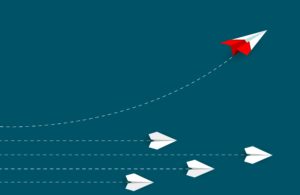There is a lot of talk about innovation in business these days; about creativity, not so much.
And yet, the two go hand in hand.
- Creativity in a business environment stands for the ability to develop new ideas and to discover new ways of looking at problems.
- Innovation, on the other hand, is the ability to use creative ideas in the development of products, services, or solutions that result in competitive advantage.
So, if you believe that creativity fuels innovation, the question then becomes how can my business become more creative?
Whose job is it?
Let’s start with the question of whose job is it to drive creativity and innovation. I’ll give you a clue.
If you take a look at the companies that make BCG’s 2019 Most Innovative Companies report you’ll notice many of them are led by a CEO who is involved hands-on in innovation. Think of Jeff Bezos, Elon Musk, and of the late Steve Jobs, to name a few.
In fact, the authors* of the book “The Innovators DNA” found that the CEOs of the most innovative companies spend 50% more time on innovation than the rest of their peers.
True, some people seem to be born creative. Does that mean the rest of us don’t stand a chance?
It does not, say the same authors. According to their research findings, cultivating what they call the five “discovery skills” (Associating, Questioning, Observing, Experimenting, and Networking) can make you a more creative and innovative leader.
Based on my personal experience working with a lot of startups recently, I agree with the promise of the five discovery skills. Let me share a couple of those examples.
Associating
Let’s talk about Associating, which I think of as connecting the dots.
Steve Jobs used to say he lived at the intersection of liberal arts and technology. It was his ability to connect otherwise disparate disciplines, such as calligraphy and computer design, to surprise customers with things they would simply love, like having different fonts in the McIntosh.
This is a perfect example of the Association skill. Had he not had a love for calligraphy he might have launched the Macintosh with a single typeface offering, just like everyone else.
Here is another example.
Most city lights around the world feature a power socket on their top surface, which is often used to power a photocell.
Then one day Tre Zimmerman, the creative and inquisitive co-founder and CTO of Ubicquia** realized that socket could be used for more productive things than just turn the light off and off.
Enter Ian Aaron, the company’s CEO. He developed the idea into a set of innovative hardware and software solutions that are being marketed worldwide. These include streetlight-monitoring applications, public Wi-Fi, vibration sensors to alert city managers when hurricane winds threaten to down a light, even small cells to increase the penetration of 4G and even 5G networks.
The Associating skill was present here when Zimmerman and Aaron thought of connecting an underutilized power socket on streetlights with a new device that provides connective capabilities to smart cities.
Questioning
Let’s turn now to another of the discovery skills: Questioning.
After a technical malfunction in the 911 Service led to a delay in locating and rescuing his father following a fall, Michael Martin resolved to find a way to create a more accurate and timely alternative.
With lots of questions in his mind, Martin got in his car and drove throughout the country, stopping at 911 centers to ask questions, trying to figure out why, in his father’s case and maybe others, the system did not work the way it was intended to.
It turns out the 911 system was designed in a voice-centric world. Until recently you could not send a text to 911 from most locations.
Martin’s idea was to change the 911 Service from being voice-centric to data-centric so that the location data could get to the operator at the same time, if not before, he or she received the call. That minimizes or eliminates the need for the person in who is in trouble to have to provide the address where help is needed.
The fruit of all that questioning and research is RapidSOS,*** the company Martin co-founded and now leads as CEO. As a result, today people’s lives stand a better chance of being saved with RapidSOS.
Experimenting
Experimenting is, in my view, the most admirable of the discovery skills. It takes a lot of determination to try and try again as many times as it takes.
Think of Thomas Edison, who famously said he had not failed 10,000 times but that, rather, had found 10,000 ways his idea would not work. How’s that for perseverance?
“Our greatest weakness lies in giving up,” he cautioned. “The most certain way to succeed is always to try just one more time.”
That’s exactly what Turkey’s Entella team, winner of the 2018 Junior Achievement Europe Company of the Year Competition, did to come up with a successful idea. In their acceptance remarks the team leaders explained how, even after their idea failed time after time after time, they continued to tweak it until they achieved success.
To me, experimenting and failing are an integral part of creativity and innovation. If you cannot tolerate risk and failure you’re never going to be very innovative.
Create, you must
It has never been more important for all of us, whether we were born with a creative trait or not, to cultivate and strengthen the five discovery skills I discussed here.
Given the rapid rate of change we are experiencing, I believe the future will belong to those who continue to foster a creative environment, one that leads to innovative solutions in the marketplace.
Ralph
* Jeffrey H. Dyer, Hal Gregersen, and Clayton M. Christensen, authors of The Innovators’ DNA
** I am an investor in Ubicquia and serve as vice-chairman of the company
*** I am an advisor and investor in RapidSOS



